The EHSO Research Safety team conducts assessments of research spaces to help ensure a safe work environment, to identify and correct laboratory hazards and to assist with regulatory compliance. Due to the COVID-19 pandemic, a modified assessment visit will be conducted for your laboratory following current safety recommendations.
What to expect?
- A 15-minute visit with your Research Safety Building Liaison to review specific safety items.
When will the lab assessment occur?
- Principal investigators and/or managers will be given a block of time when the safety liaison will come by.
- Lab assessments will start February 1st.
How can I prepare for the lab assessment? The following items will be reviewed during the walk-through.
- Administration and Training
- All lab personnel are listed in the BioRAFT “Members” tab and appropriate job activity(s) is checked for each person.
- Lab Self Inspection (LSI) has been completed within the last 12 months.
- All lab personnel have completed the EHSO training in BioRAFT.
- Disinfection and Hand Hygiene
- Lab maintains supplies for surface decontamination and disinfection:
- There are supplies (paper towel/cloth, disinfection solution, etc.) available for surface decontamination and disinfection activities.
- High touch surfaces are disinfected regularly.
- Lab maintains handwashing facilities:
- There is at least one sink within the lab that has handwashing soap and paper towels.
- Paper towels are stored in a manner that prevents contamination.
- If lab is not equipped with sink/running water, hand sanitizer is available.
- Sinks are free of foreign objects or solid waste that could clog drain.
- Emergency Preparedness
- All emergency safety equipment is unobstructed:
- Includes: fire extinguisher, eyewash, safety shower, fire alarm pull station
- Fire extinguishers are inspected:
- Monthly visual inspections documented on inspection tag.
- Annual inspection documented on inspection tag.
- Eyewash equipment is maintained:
- Plumbed eyewashes have protective caps in place.
- Plumbed eyewash eye pieces and caps are free from contamination.
- Plumbed eyewash activations are performed and documented at least monthly.
- Supplemental eyewash bottle(s) are not expired.
- Engineering Controls
- The following equipment has been certified within the last 12 months or have been tagged Out-of-Service:
- Biological Safety Cabinets (BSCs)
- Laminar Flow Hoods (LFH) / clean benches
- Chemical Fume Hoods (CFHs), snorkels, and downdraft tables
- Housekeeping
- Food / drink / cosmetics are not present in the lab.
- Lab doors are not left open or ajar.
- Lab is free from slip, trip and fall hazards.
- Regulated Waste
- Sharps are disposed of in appropriate waste collection containers:
- sharps container = needles, glass Pasteur pipettes, unfixed specimen slides, biologically contaminated glass
- cardboard broken glass box = clean glass, fixed specimen slides
- solid waste bucket = chemically contaminated glass
- Sharps containers are closed and disposed of when contents reach manufacturer’s fill line, or if fill line is not present, no greater than 3/4 full.
- Cardboard broken glass boxes have a plastic liner and are taped closed and disposed of when no greater than 3/4 full.
- Sharps are not disposed of in regular trash or biohazard bags.
- Chemical waste is maintained in the lab according to Emory’s Regulated Waste Guidelines:
- The final destination for chemical waste is EHSO.
- All chemical waste containers are labeled with GHS hazard class pictogram(s) and EHSO Hazardous Waste Label at start of generation. [EHSO Hazardous Waste Label includes: PI name, building/room number, phone number, list of all constituents & concentrations, and associated hazard class of each constituent]
- Chemical waste is stored in compatible container and that the container is in good condition.
- Liquid chemical waste is stored in secondary containment.
- Chemical waste streams are separated by compatibility and incompatible wastes are segregated by a physical barrier.
- Chemical waste containers are closed, except when actively adding waste to container.
- Chemical waste storage must not exceed 5 gallons per container, 1 quart of P-listed waste, or a total of 50 gallons of all waste at one time.
- The lab must designate an area for chemical waste storage within the space it is generated, and waste cannot be transferred to any area that requires passage through a door.
- Empty chemical containers (non-P-listed) are triple rinsed, defaced, caps removed, and disposed of via regular trash or recycling.
- The chemical waste storage area, or Satellite Accumulation Area (SAA), is free of spilled or leaking waste.
- Biohazard waste is identified, collected, and separated from other waste streams to ensure proper decontamination:
- Waste containers, including plastic bags/liners, must be labeled with biohazard symbol and the word “biohazard.”
- Waste containers, including benchtop collection, must be closed except when adding waste.
- Liquid biohazard waste is collected in leak-proof container and decontaminated before disposal.
- Untreated biohazard waste is not poured down the drain, discarded in regular trash, or mixed with chemical waste streams.
- Solid biohazard waste is collected in/transferred to Stericycle containers when 3/4 full. Stericycle boxes are closed, sealed, and labeled for disposal.
- Filled sharps containers are disposed of via Stericycle (sharps containers are not to be autoclaved and/or disposed via regular trash).
- Stericycle waste manifests are maintained for at least 3 years for documentation and tracking purposes.
- Sharps are disposed of in appropriate waste collection containers:
- The following equipment has been certified within the last 12 months or have been tagged Out-of-Service:
- All emergency safety equipment is unobstructed:
- Lab maintains supplies for surface decontamination and disinfection:
Please contact your Research Safety Building Liaison if you have any questions.

